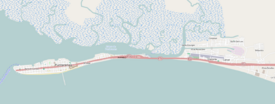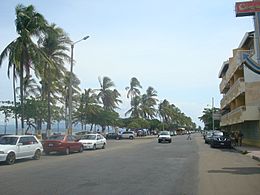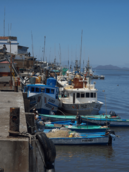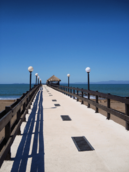Puntarenas facts for kids
Quick facts for kids
Puntarenas
|
|||
|---|---|---|---|
|
Images, from top down, left to right: the Port Laborer Monument, Tourists Pass Avenue, The Cathedral within Central Park, Coral Princess docked at Puntarenas' Port, docked fishing boats, Puntarenas Pier.
|
|||
|
|||
| Nickname(s):
La Perla del Pacífico
"The Pacific Pearl" |
|||

Puntarenas and surrounding area
|
|||
| Country | Costa Rica | ||
| Province | Puntarenas | ||
| Canton | Puntarenas | ||
| Districts | Puntarenas, Chacarita, El Roble | ||
| Creation | 17 September 1858 | ||
| Area | |||
| • Total | 47.46 km2 (18.32 sq mi) | ||
| Elevation | 5 m (16 ft) | ||
| Population
(2011)
|
|||
| • Total | 41,528 | ||
| • Density | 875.01/km2 (2,266.27/sq mi) | ||
| • Demonym | Puntarenense | ||
| Time zone | UTC-6 (Central) | ||
| Postal code |
60101, 60112, 60115
|
||
| Area code(s) | + 506 | ||
| Climate | Aw | ||
| Website | [1] | ||
Puntarenas is a lively city located on the Pacific coast of Costa Rica. It's the capital of the Puntarenas Province. The city includes three main areas: Puntarenas, Chacarita, and El Roble. It's a very important place for the region.
Contents
Understanding the Name of Puntarenas
The name Puntarenas is a mix of two Spanish words. Punta means "point," and arenas means "sands." So, the name means "Sand Point."
The name was first written down in 1720. A pirate named John Clipperton arrived there. He wrote in his notes about a "Punta de Arena." This was the narrow, sandy area where the city stands today. The larger Puntarenas Province also shares this name. It is the biggest province in Costa Rica.
Exploring Puntarenas: A Coastal City
About 100,000 people live in Puntarenas and its nearby areas. The city's Pacific Ocean beaches are very popular. Many tourists visit, especially those who love to surf. It's also a good place to stop if you are going to Monteverde, a famous tourist spot to the northwest.
The city's port, called Caldera, is one of the main ports in Costa Rica. It is also the oldest port in the country. You can take regular ferries from Puntarenas to the Nicoya Peninsula.
The History of Puntarenas
Puntarenas was first found by Gil González Dávila in 1522. For a long time, the Gulf of Nicoya was used to enter Costa Rica's inland areas. However, the port of Puntarenas itself didn't become important until 1840. This was when coffee production in the mountains grew enough to be exported.
In 1845, the government made Puntarenas a duty-free port. This meant that most goods brought into the port didn't have extra taxes. At first, coffee was carried to the port by oxcarts. They traveled on a trail through the mountains.
Connecting Puntarenas by Railway
In 1859, a railway line was finished. It connected Puntarenas to the town of Esparza. Esparza was one of the first Spanish settlements in Costa Rica, founded in 1574. Eventually, the railway was built all the way to San José. Train service started in 1910.
The railway connection helped the Pacific port stay important. It was a major part of the region's economy for many years.
Modernizing the Port Facilities
As time passed, the old port facilities became too old. Also, modern ships became much larger. So, a new port was built in the 1980s. It was built south of Puntarenas, in a place called Caldera. Ships had anchored in Caldera even in colonial times. Caldera was a better spot for bigger ships. It was actually the first port used in the area since 1522.
Sports in Puntarenas
Puntarenas has some important football (soccer) teams. The Puntarenas F.C. team has played many seasons at the highest level. Jacó Rays is another team from the city.
Delicious Food in Puntarenas
Since Puntarenas is a big port city on the Pacific coast, its food often includes seafood. A popular dish is ceviche, which is fresh seafood marinated in citrus juices.
A very famous dessert in Puntarenas is the Churchill. It's a special type of snow cone that many people enjoy.
Puntarenas Climate
Puntarenas is usually hotter than the Costa Rican Central Valley. Daytime temperatures often range from about 30 to 35 degrees Celsius (86 to 95 degrees Fahrenheit). The hottest months are usually April and May.
| Climate data for Puntarenas | |||||||||||||
|---|---|---|---|---|---|---|---|---|---|---|---|---|---|
| Month | Jan | Feb | Mar | Apr | May | Jun | Jul | Aug | Sep | Oct | Nov | Dec | Year |
| Mean daily maximum °C (°F) | 33.5 (92.3) |
34.4 (93.9) |
34.0 (93.2) |
34.6 (94.3) |
33.1 (91.6) |
32.2 (90.0) |
32.2 (90.0) |
32.2 (90.0) |
31.9 (89.4) |
31.6 (88.9) |
31.8 (89.2) |
32.0 (89.6) |
32.8 (91.0) |
| Daily mean °C (°F) | 27.6 (81.7) |
28.3 (82.9) |
28.5 (83.3) |
29.2 (84.6) |
28.6 (83.5) |
27.9 (82.2) |
27.7 (81.9) |
27.7 (81.9) |
27.5 (81.5) |
27.4 (81.3) |
27.3 (81.1) |
27.1 (80.8) |
27.9 (82.2) |
| Mean daily minimum °C (°F) | 21.7 (71.1) |
22.2 (72.0) |
22.9 (73.2) |
23.7 (74.7) |
24.1 (75.4) |
23.6 (74.5) |
23.2 (73.8) |
23.1 (73.6) |
23.1 (73.6) |
23.2 (73.8) |
22.8 (73.0) |
22.1 (71.8) |
23.0 (73.4) |
| Average rainfall mm (inches) | 5.5 (0.22) |
4.1 (0.16) |
4.9 (0.19) |
30.3 (1.19) |
204.1 (8.04) |
217.3 (8.56) |
175.7 (6.92) |
223.1 (8.78) |
296.1 (11.66) |
279.1 (10.99) |
132.0 (5.20) |
27.7 (1.09) |
1,599.9 (63) |
| Average rainy days | 1.8 | 1.9 | 2.9 | 7.8 | 19.1 | 21.0 | 18.0 | 21.8 | 24.3 | 24.5 | 14.7 | 5.7 | 163.5 |
| Mean monthly sunshine hours | 263.5 | 254.3 | 282.1 | 255.0 | 201.5 | 156.0 | 164.3 | 170.5 | 159.0 | 167.4 | 183.0 | 232.5 | 2,489.1 |
| Source 1: World Meteorological Organization | |||||||||||||
| Source 2: Hong Kong Observatory | |||||||||||||
See also
 In Spanish: Puntarenas (ciudad) para niños
In Spanish: Puntarenas (ciudad) para niños









